SEA URCHIN

Red sea urchins (Photo Credit : Paul Nicklen/Nationa Geographic)
Sea urchins are closely related to sea cucumbers (Holothuroidea) and are macrobenthos of the class Echinoidea in the phylum Echinoderms.
This biota is an animal that only lives in the sea, has a pentaradial symmetrical body, and possesses an endoskeleton in the form of a chalky skeleton. Sea urchins have clear spines, but in some species they are modified into a shield-like shape, an example is Colobocentrotus atratus. Sea urchins, like other echinoderms, also have tube feet that are part of the canal system. In sea urchins, there are pedicellaria, which are organs also found in starfish. Sea urchins also have a unique jaw and tooth system called Aristotle’s lantern.
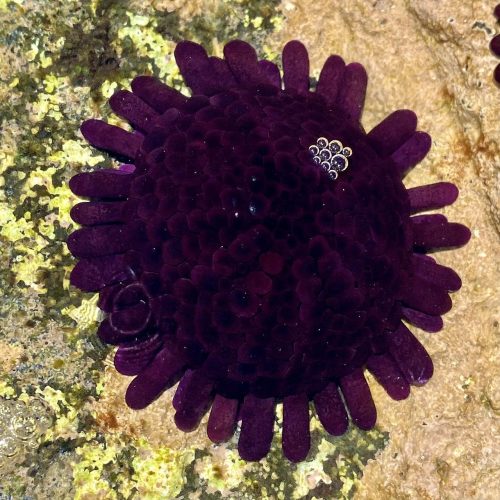
Colobocentrotus atratus (Photo Credit : Dayna Bubenicek)
Sea urchin spines vary in shape and size, depending on the type. Some (adult) sea urchin spines are needle-shaped with a diameter of less than 1 millimeter, while others are pencil-shaped with a thickness of almost 1 cm. Some types of sea urchins such as Prionocidaris verticillata have ornamental spines and look like a crown of spines. Sea urchin spines also have a function for defense and movement. In its function as a defense tool from predators, some species have poisonous spines such as Diadema antillarum and Asthenosoma varium. Diadema setosum has long, sharp spines but is very fragile. If Diadema spines pierce tissue (animal or human), they break off in the tissue and are difficult to remove, causing pain around the puncture area.
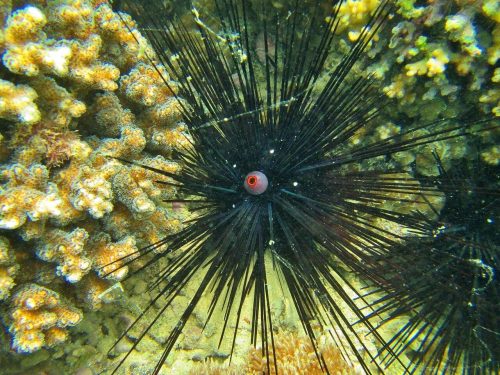
Diadema setosum (Photo Credit : Frédéric Ducarme)
About 950 species inhabit the deep seabed as benthic in every depth zone, ranging from rocky beaches to depths of 5,000 meters. The sea urchin shell, called testa, is generally round and hard, covered with thorns. This testa is found fossil form dating back to the Ordovician (about 450 million years ago).
Most sea urchin spines range from 3 to 30 cm in length with a diameter of up to 1.65 cm and a weight of 200 grams. They move slowly, crawling with tube feet and propelling themselves with spines.
Some species of sea urchins are exotic due to their diversity of colors and shapes including: Heterocentrotus mamilatus, Astropyga radiata, Strongylocentrotus purpuratus, Echinothrix calamaris, Stylocidaris affinis, Amblypneustes elevatus, Asthenosoma ijimai.
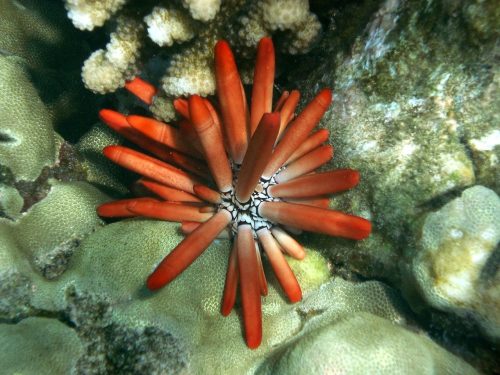
Heterocentrotus mamilatus (Photo Credit : Scott Roy Atwood)
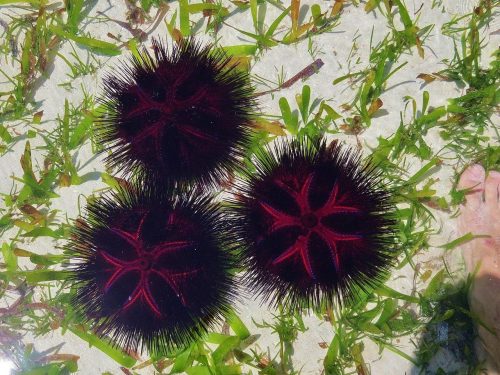
Astropyga radiata (Photo Credit : Fred D)

Strongylocentrotus purpuratus (Photo Credit : Taollan82)

Echinothrix calamaris (Photo Credit : Anders Poulsen)
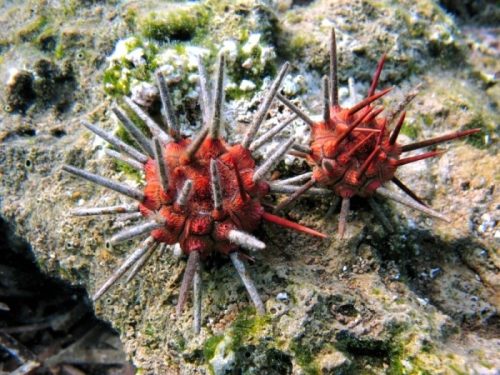
Stylocidaris affinis (Photo Credit : Roberto Pillon)
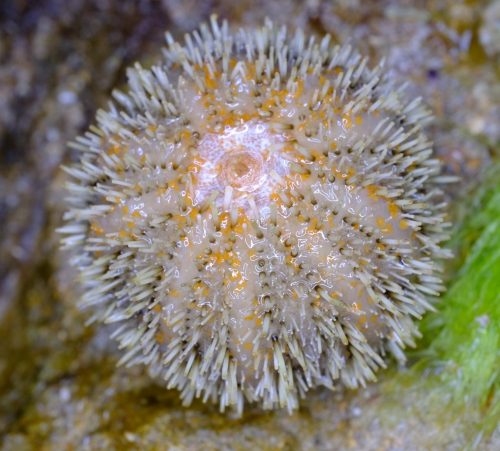
Amblypneustes elevatus (Photo Credit : Peter Crowcroft)
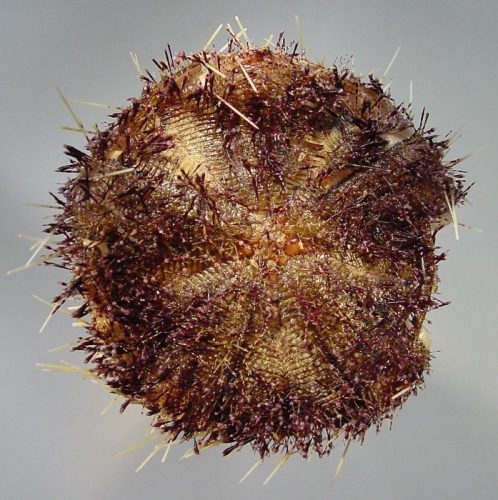
Asthenosoma ijimai (Photo Credit : Henk von Noordenburg)
This animal has been studied since the 19th century as model organism in developmental biology because its embryos are easy to observe. This research has continued into genome studies due to their unusual fivefold symmetry and their relationship to chordates.
The type of food depends on each habitat. In general, sea urchins are characteristic of animals that eat small particles and plankton or small organisms in the waters. In seagrass habitats, we will find sea urchins with omnivorous types. Sea urchins can feed on small and macroalgae organisms or better known as grazers, Diadema setoriums is one example of an omnivorous sea urchin.
In the process of finding food, sea urchins use their two organs, namely tube legs and pedicellaria. Algae is the main food of this biota so species such as pencil sea urchins are very popular in aquariums, because they are useful for controlling algae. In addition to algae, this biota also eats other animals that have slow movements. Predators of these biotas include a wide variety of fish, starfish, crab, marine mammals, and also human.
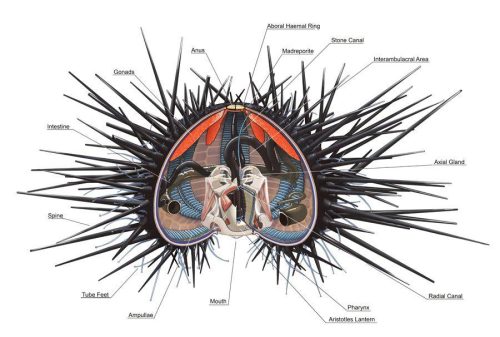
Sea urchin anatomy (Photo Credit : Alex Ries)
The digestive tract starts from the mouth, which is at the bottom right in the middle of the body, and continues to the esophagus, stomach (which has been modified into small sacs), intestines, rectum, and ends at the anus, which is right on the opposite side of the mouth. If the mouth is located in the central oral area, then the anus is located at the top (aboral) of their body.
Sea urchins reproduce sexually with separate male and female individuals. Their life stages start from Blastula, then Pluteus, and finally Juvenile sea urchin. It is at this juvenile stage that they attach to substrate and develop into adults individuals.
Taxonomy
The class Echinoidea is divided into 4 Sub-Classes, which are listed in the taxonomy list below:
Phylum : Echinoderms
Subfilament : Echinozoa
Class : Echinoidea (Leske, 1778)
- Sub-classes Perischoechinoidea
- Order Cidaroida
- Sub-class Euechinoidea
- Superordo Atelostomata
- Order Cassiduloida
- Order Spatangoida
- Superordo Diadematacea
- Order Diadematoida
- Order Echinothurioida
- Order Pedinoids
- Superordo Echinacea
- Order Arbacioid
- Order Echinoida
- Order Phymosomatoid
- Order Salenioida
- Order Temnopleuroida
- Superorder Gnathostomata
- Order Clypeasteroida
- Order Holectypoida
- Superordo Atelostomata
Roles and Benefits
Ecologically, sea urchins play an important role in maintaining the balance of seaweed. The main reason is their role as consumers of algae. Through this type of diet, sea urchin populations help manage seaweed populations and prevent an excess of juveniles that can damage and injure other ecosystems. In addition, many species of sea urchins are consumed by several marine predators, such as fish and birds, which makes these organisms important consumers in the oceanic food chain.
Sea urchins have high economic value, both in the past and present. In some places in Indonesia, sea urchins are also known by the public as a food source. This fauna is widely caught by the surrounding community for their eggs (gonads), which are used as a daily food item. Chasanah and Andamari (in Radjab, 2001) mentioned that sea urchin eggs have high nutritional value, with a protein content in wet weight between 7.04-8.20% and a protein content in dry weight between 51.80-57.80%. The fat content in wet weight is between 1.14-1.35% and in dry weight is between 8.53-9.36%. In Indonesia, sea urchins are mostly used for household consumption by catching them directly in their habitat without any commercialization or cultivation efforts. Some sea urchins found in shallow waters and have economic value include Diadema setosum and Temnopleurus alexandrii, which are generally consumed in the form of raw or processed gonads.
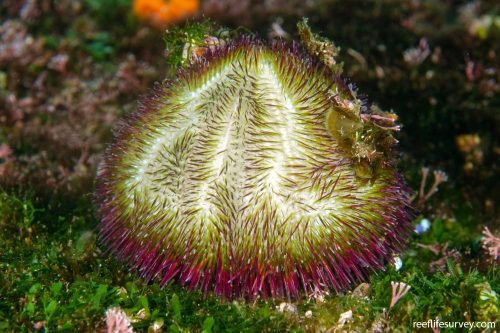
Temnopleurus alexandrii (Photo Credit : Reeflifesurvey.com)
The threats posed by climate change and rising ocean temperatures, which can lead to changes in food patterns, sea urchin loss, and habitat destruction, threaten the survival of the species. Human actions are also a serious threat to the survival of sea urchins and the marine environment.
Conservation Efforts of Sea Urchins
To protect sea urchins from extinction and prevent them from becoming an endangered species, various conservation measures have been implemented by all parties involved. The primary goal is to increase public awareness and knowledge about the need to safeguard these species and the marine ecosystems in which they live. In this regard, society has an important obligation to become more aware of the existence of these species and to carry out the protection and maintenance of sea urchin habitats. Meanwhile, the state regulates and enforces laws on fishing and the trade or export of sea urchins.
-YN

